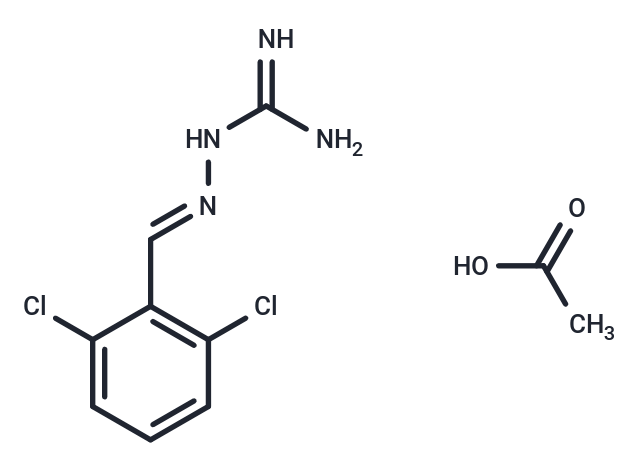Shopping Cart
- Remove All
 Your shopping cart is currently empty
Your shopping cart is currently empty

Guanabenz Acetate (Wytensin) is a specific agonist of adrenergic receptor. The pEC50 for α2a-adrenergic receptor, α2b-adrenergic receptor and α2c-adrenergic receptor is 8.25, 7.01 and ~5, respectively.

| Pack Size | Price | Availability | Quantity |
|---|---|---|---|
| 200 mg | $30 | In Stock | |
| 500 mg | $40 | In Stock | |
| 1 g | $56 | In Stock | |
| 1 mL x 10 mM (in DMSO) | $29 | In Stock |
| Description | Guanabenz Acetate (Wytensin) is a specific agonist of adrenergic receptor. The pEC50 for α2a-adrenergic receptor, α2b-adrenergic receptor and α2c-adrenergic receptor is 8.25, 7.01 and ~5, respectively. |
| Targets&IC50 | α2A-adrenoceptor:8.25(pEC50), α2B-adrenoceptor:7.01(pEC50), α2C-adrenoceptor:<5(pEC50) |
| In vitro | Guanabenz inhibits the response of vascular contractions in various processes and initiates normal sympathetic nerve discharge, while also antagonizing the stimulation of the sympathetic nervous system. Administering 0.5 mg/kg of Guanabenz intravenously in anesthetized hypertensive rats and dogs leads to a reduction in blood pressure and heart rate. Moreover, an intravenous injection of 0.1 mg/kg Guanabenz in anesthetized dogs initially causes an increase in blood pressure due to the action of the sympathetic nervous system, followed by a decrease in cardiac output, contractility, and heart rate. |
| In vivo | In mammalian MovS6 cells, 10 μM of Guanabenz facilitates the complete clearance of PrPSc. Additionally, in HEK293 cells transfected with rat inducible nitric oxide synthase (nNOS), 30 μM Guanabenz induces a time-dependent reduction in nNOS activity, with a Ki value of 1 μM. In HEK 293 cells, treatment with 50 μM Guanabenz for 3 hours results in approximately a 75% decrease in the accumulation of nitrites and nitrates within the cells. Furthermore, treatment with 100 μM Guanabenz for 24 hours leads to about a 35% reduction in the quantity of inducible nitric oxide synthase protein detected by immunological methods. |
| Alias | Wytensin, Wy8678 acetate, BR-750 |
| Molecular Weight | 291.13 |
| Formula | C8H8Cl2N4·C2H4O2 |
| Cas No. | 23256-50-0 |
| Smiles | c1(c(cccc1Cl)Cl)/C=N/NC(=N)N.C(=O)(C)O |
| Relative Density. | no data available |
| Storage | Powder: -20°C for 3 years | In solvent: -80°C for 1 year | Shipping with blue ice. | |||||||||||||||||||||||||||||||||||
| Solubility Information | DMSO: 40 mg/mL (137.4 mM), Sonication is recommended. | |||||||||||||||||||||||||||||||||||
Solution Preparation Table | ||||||||||||||||||||||||||||||||||||
DMSO
| ||||||||||||||||||||||||||||||||||||

Copyright © 2015-2025 TargetMol Chemicals Inc. All Rights Reserved.